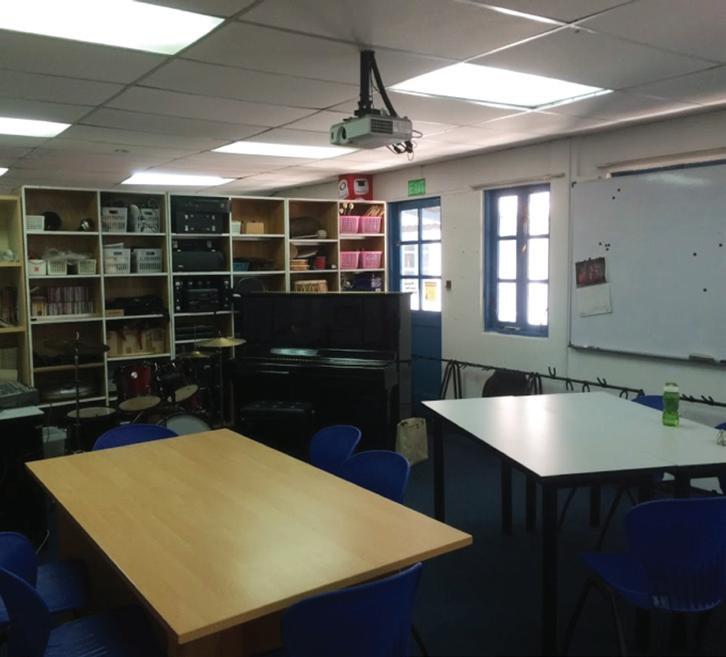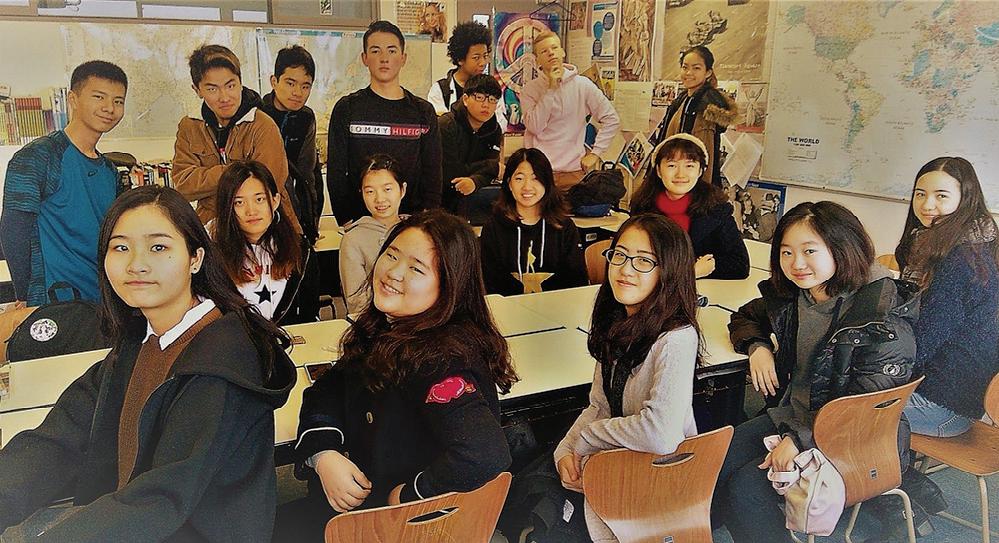
8 minute read
Learning Spaces
Learning Spaces Developing Classroom Design to Promote Learning
By Christopher Hoddinott ISS International School, Singapore.
When I first moved into my classroom at ISS International School, Singapore (ISS), I dreamt of how I could turn the area into a learning space, where students could be creative, comfortable, safe and have an appetite for learning. I asked questions such as; what would encourage inquiry? What would support the development of communication, social, creative thinking and critical skills? What would help my students to become better musicians?
Promoting both Formal and Informal Learning As a result, the classroom had to be redesigned to promote inquiry informal learning, where the learning is structured within the curriculum, and informal learning where students can come into the room in their spare time, use the instruments and explore for themselves the world of music. The design of the classroom during formal learning needed to promote student engagement with both the teacher and students in the room, groups were to be flexible and move around to encourage communication skills, and students were to come into the classroom to be enthusiastic to learn about music. With informal learning, Green (2006), in her book ‘Music, Informal Learning and the School: A New Classroom Pedagogy’ , suggests students should have a more authentic way of learning similar to those of professional musicians where they can interact within friendship groups and draw on their own passions and interests under their own direction.
Opening the Space Space was limited for students to communicate and the desks acted as barriers for students to talk and compare ideas. It also meant students were confined to one point in the room, and one perspective. They could only really speak to students in their immediate space. Students felt they could not move around the area freely, and thus be able to talk with everyone to interact and share ideas. It limited creativity as ideas were naturally directed to the teacher to dissect rather than to the students to share and develop themselves. The room was designed for teacher -led work rather than student- led activities..
Space before. The space after.

Opening the space allowed more significant student interaction. They were able to be engaged and develop their own learning and improve approaches to learning (ATL) skills such as communication, collaboration, creative thinking, critical thinking and affective skills. It enabled learning not to be directed to the teacher space in the room but dispersed throughout the whole classroom. The introduction of bean bags meant students could be comfortable while they learned thus helping them to be more relaxed and focused on learning within the classroom. It resulted in learning that was less teacher directed and thus brought together elements of informal learning into the formal lesson structure, enabling learning to be more authentic for the learner. The emphasis of the learning is on the student and what they want to learn and discover rather than the teacher leading the inquiry cycle. Students, therefore, experience a more personalised approach to learning through the social interactions of others (Eraut, 2004).
A sense of belonging Students, through greater social interaction, benefit from more significant development of creative and critical thinking skills as well as expertise in playing their musical instruments and honing their music listening skills. Consequently, they learn to cooperate and interact to benefit the community they are working in and not just themselves. By working together in groups they can create something bigger and better than what is possible individually. The sum of the parts is greater than the individual. Students also build friendship groups and this has a positive impact on their learning experience (Senior and Howard, 2014). We also promoted the sense of belonging by having spaces marked out for students where they can have their instruments in the classroom to use. Students owning their own musical instruments has terrific benefits as they are more inclined to practice, take care of the instrument and take ownership of their personal learning development by setting their personal goals and development targets. By allowing students to bring in their instruments they can feel that the space belongs to them and others. It is not just the space for the teacher.
What the students say, It is also important students recognise the space and know how to use the space to aid their learning. They reflect and understand how the classroom enables learning and the development of ATL skills. To quote our students at ISS.
“The music room has less tables and chairs than other classes, so there are more spaces to sit or more space to be together. Also, the music room has a big space in the middle, that helps me to sit in the middle so I could hear everyone.”
“At school, the music room design helps me work as a group because there is a big space for every one of us to sit together and play music together. The music room has a few bean bags and chairs for students to choose the one they are most comfortable with to play an instrument.”
“The room is spread out, and there is so much space so we can move around easily and get comfortable.”
“Every time I go into the music room I feel like I am going to get into music. I think the atmosphere around a place affects the person’s mood and temper very much, so the design of every classroom in school is a very important resource to switch feelings to start something new- especially art in my opinion.”
Outside of the lesson time, With the redesign of the learning space, it has also meant students have felt more welcome to come into the music room. Only during the occasional break-time, when students are busy with other projects, will the music room be empty. Students use the place to play and practice music, as well as to sit and socialise and build relationships within the school. This redesign has also enabled me as a teacher to build relationships with the students.
References Eraut, M. (2004) Informal learning in the workplace, Studies in Continuing Education, 26: 2, pp. 247-273
Green, L. (2006) Music, Informal Learning and the School: A New Classroom Pedagogy
Senior, C., and Howard, C. (2014). ‘Learning in friendship groups: developing students’ conceptual understanding through social interaction.’ Frontiers in Psychology, 1031: 5. http://doi.org/10.3389/fpsyg.2014.01031
Curriculum Putting Critical Thinking Skills into Practice
By Tara Cheney Osaka International School tcheney@senri.ed.jp
At Osaka International School of Kwansei Gakuin we are fortunate to have the freedom and support to investigate, corroborate evidence and form conclusions in relation to local historical sites / museums. Many of our students are bilingual/ trilingual and this adds to the richness of their investigative experiences, as they can research in more than one language and garner a variety of in depth perspectives.
Grade 10 International Baccalaureate Middle Years Programme (IB MYP) Individuals and Societies (I&S) students and grade 11 IB Diploma (DP) History students recently conducted an investigation into the renovated (2015) Osaka International Peace Museum. This investigation offers scope to meet the MYP I&S criterion B) INVESTIGATING as students need to:
formulate a clear and focussed research question and justify its relevance in relation to WWII and the museum formulate and follow an action plan to investigate the research question use research methods to collect and record appropriate, varied and relevant information evaluate the process and results of the investigation
Source: https://www.ibo.org/programmes/middle-years-programme/curriculum/individuals-and-societies/ - (for use from Sept. 2014)
Grade 11 IBDP History students utilised the museum field trip to inspire a topic that personally relates to their experience (local history) but also could meet their Internal Assessment Investigation. According to the IBDP History guide this investigation should be based on a specific historical inquiry that enables them to develop and apply the skills of a historian, such as, selecting and analysing a range of source material and considering diverse perspectives. The IBDP History students must search for, select, evaluate and use evidence to reach a relevant conclusion with the evidence and arguments that have been put forward in their investigation..
Keeping the grade 10 and 11 criteria in mind the students used the following general questions as a basis for their individual investigations at the Osaka International Peace Museum: • When and why was this museum originally created? • What is the purpose of this museum now? • Who curates this museum? (responsible for content) • Who funds this museum? (edits content) • How is this museum international?

How does this museum promote peace? How does this museum address why Osaka was bombed during WWII? How does the content within the displays today differ from the original content, prior to the 2015 renovation? How would you describe the content of the museum today? To what extent is information not translated from Japanese into other languages? How does omitting information or having vague, general translations mean that balanced content is lost? If the museum aims to educate Osakan elementary students about WWII what sort of understanding would these young students come away with after visiting this museum? Would young students understand anything about Japanese war crimes? e.g. the Nanking massacre, Unit 731, the Imperial Japanese Army’s sexual enslavement of women across Asia, POW abuse etc. How does the museum help Japanese elementary students understand the current diplomatic tensions between Japan and its Asian neighbours, and therefore promote peace?
In an era of immediate internet exposure to “fake news” and “alternative facts” we know it is imperative for students to develop critical thinking and analytical skills. These skills will not only mean improved academic results but will give students skills for life - purchasing in an informed and wise manner, determining real news stories and working out for themselves, using corroborated evidence, what has happened and what is really happening in the world around them.
Photo from author - grade 10 investigators!









